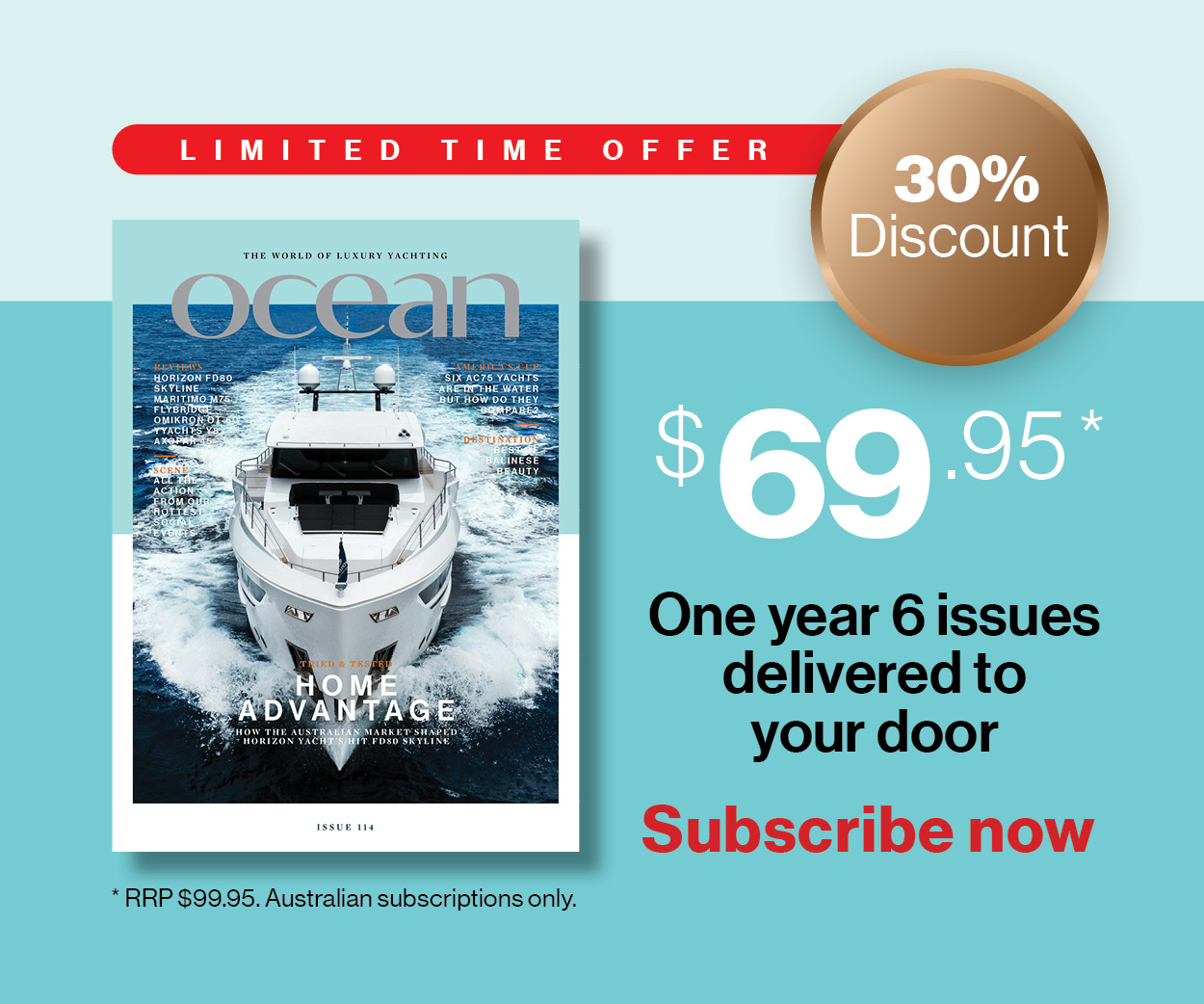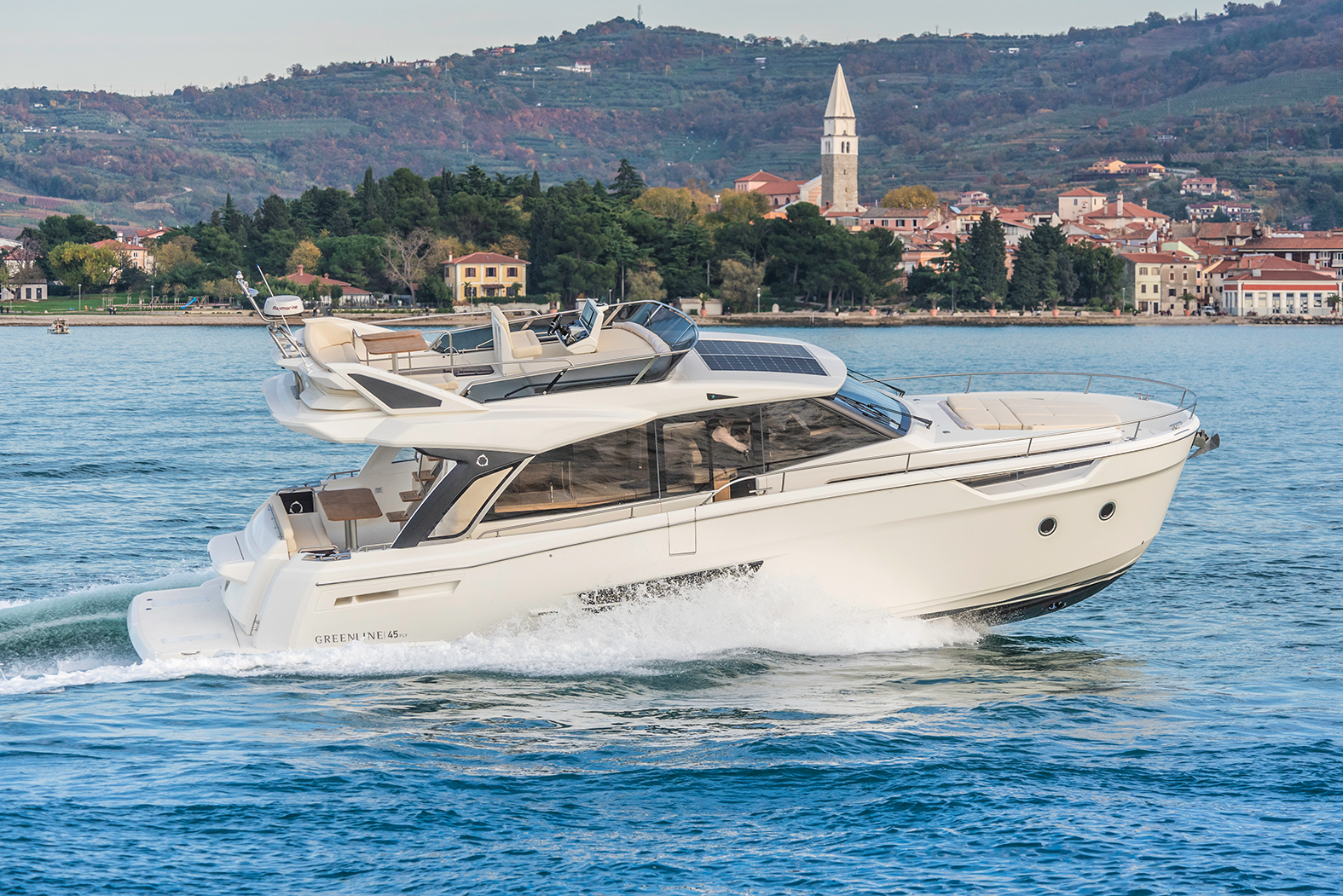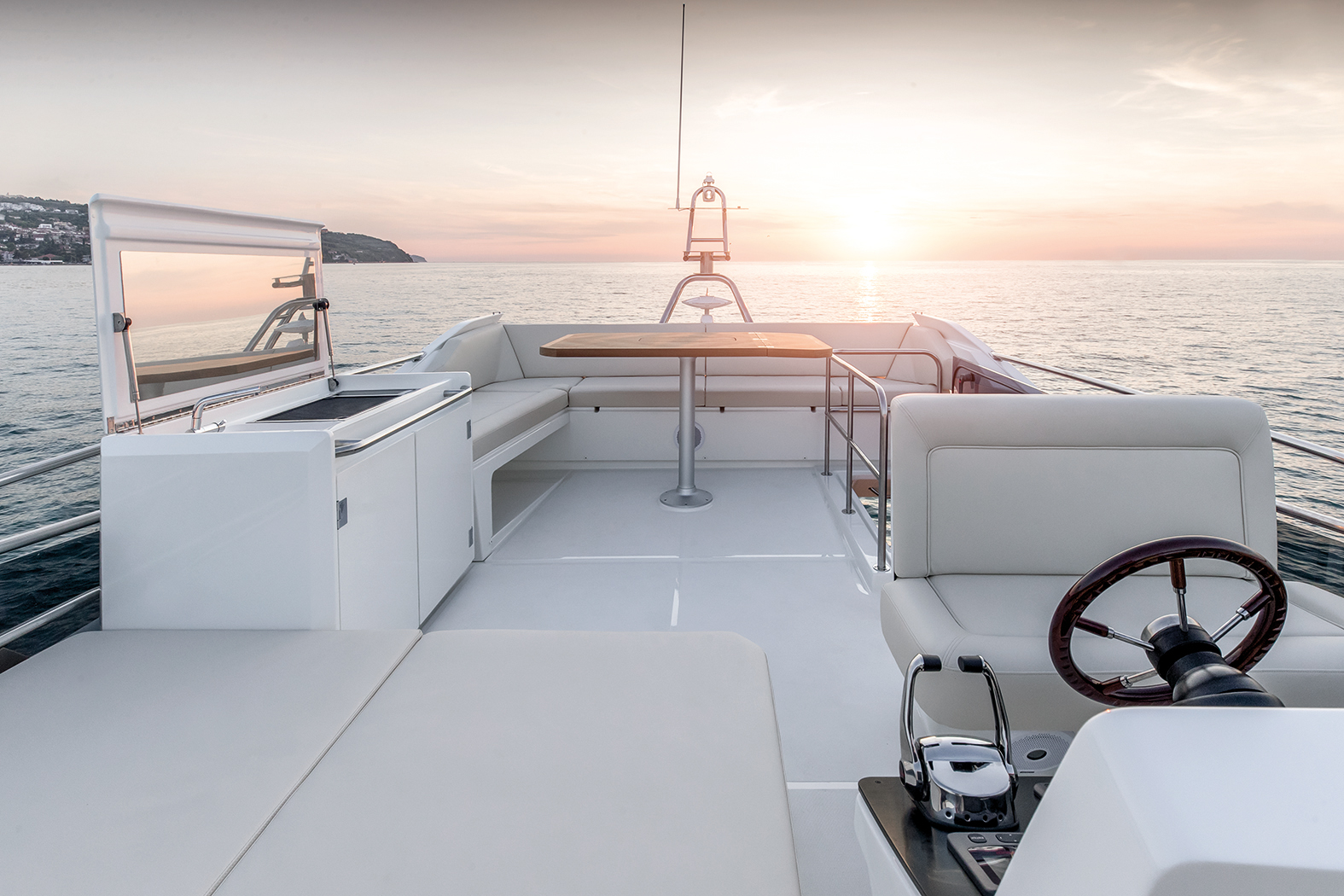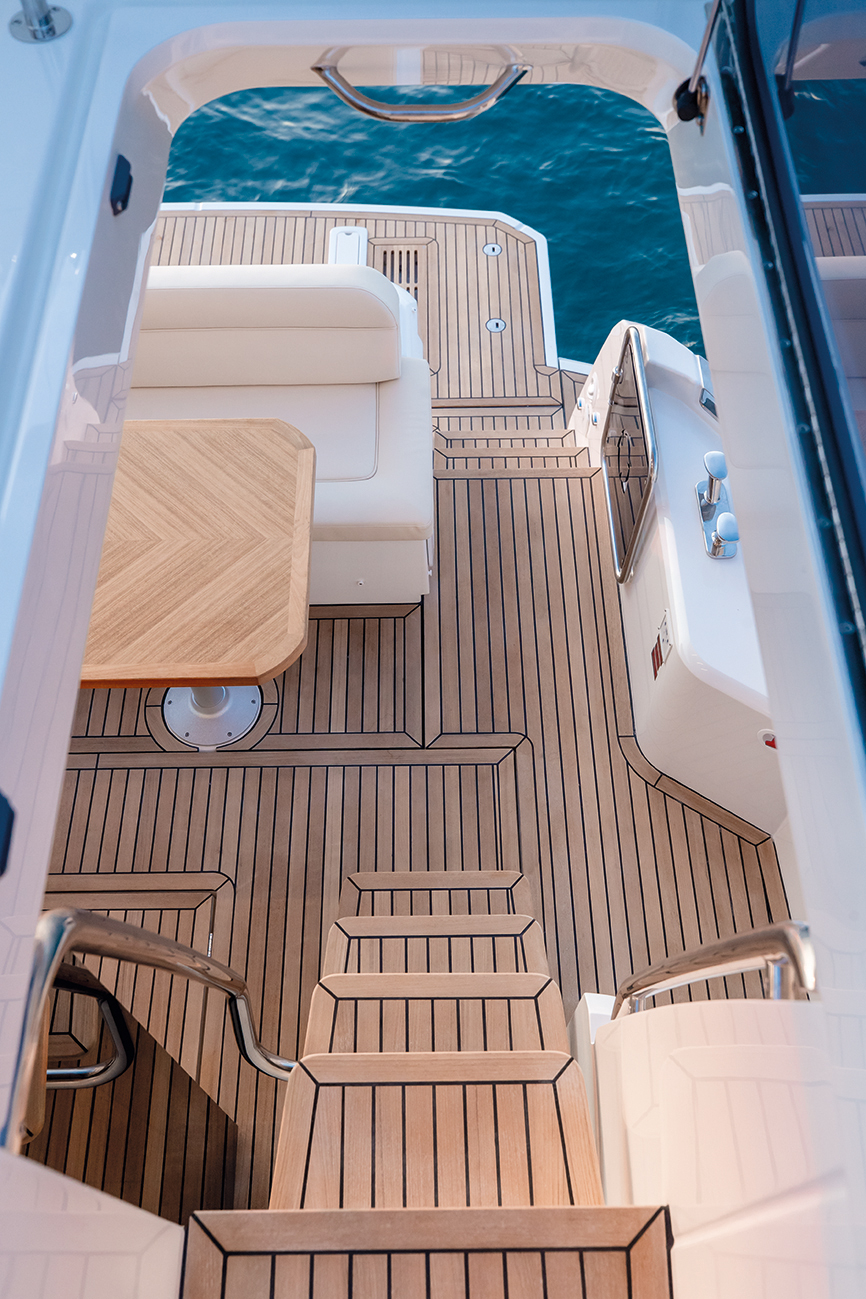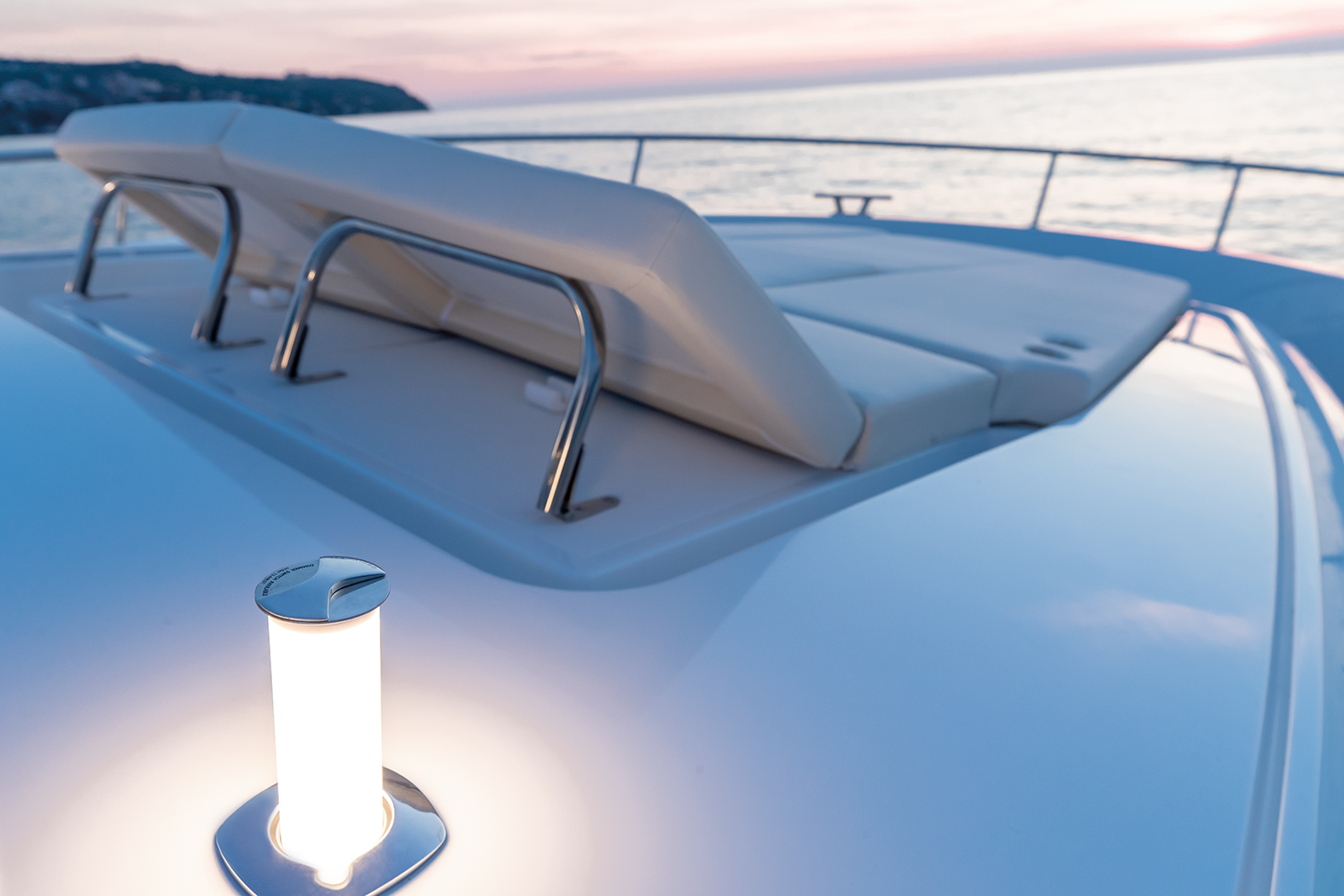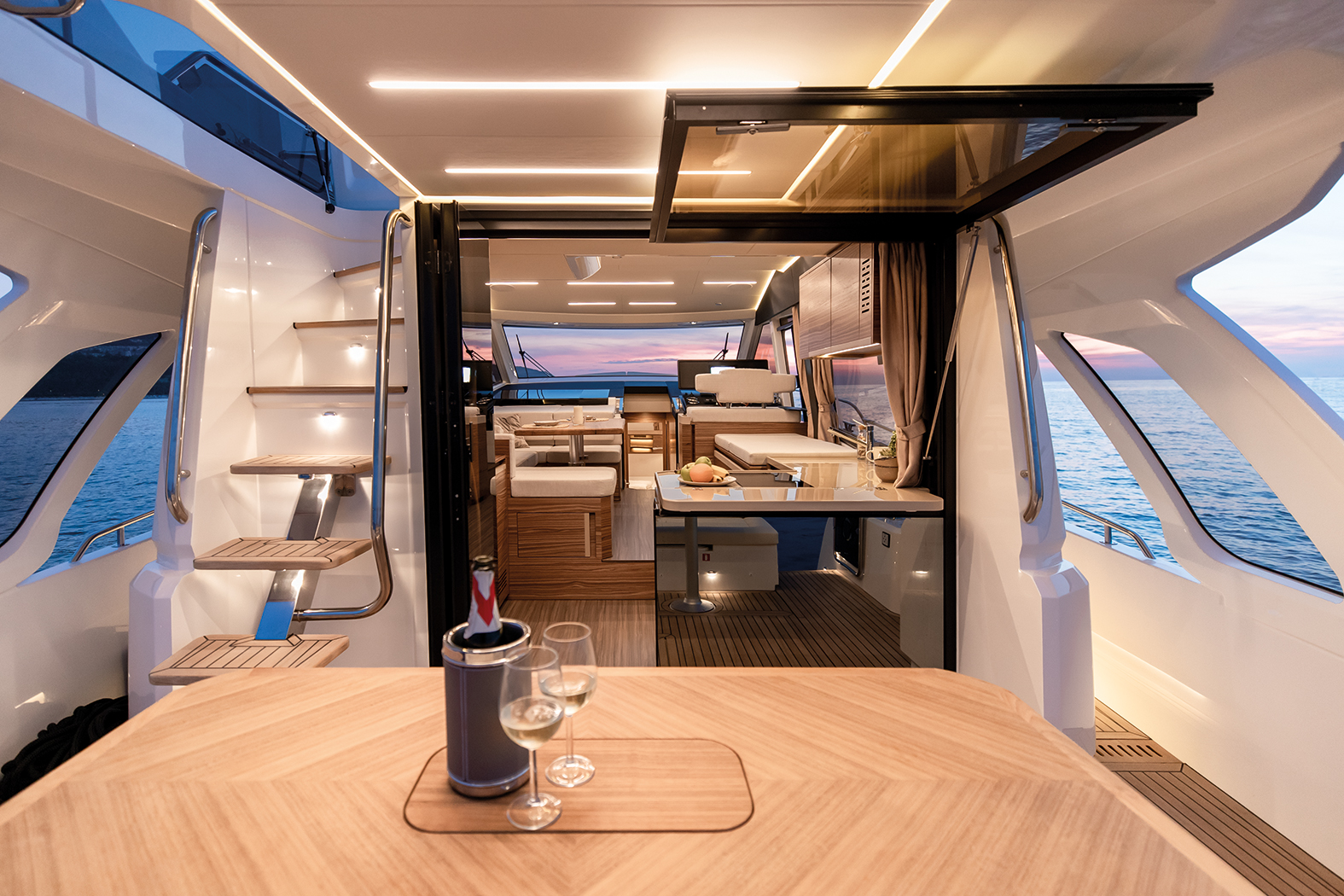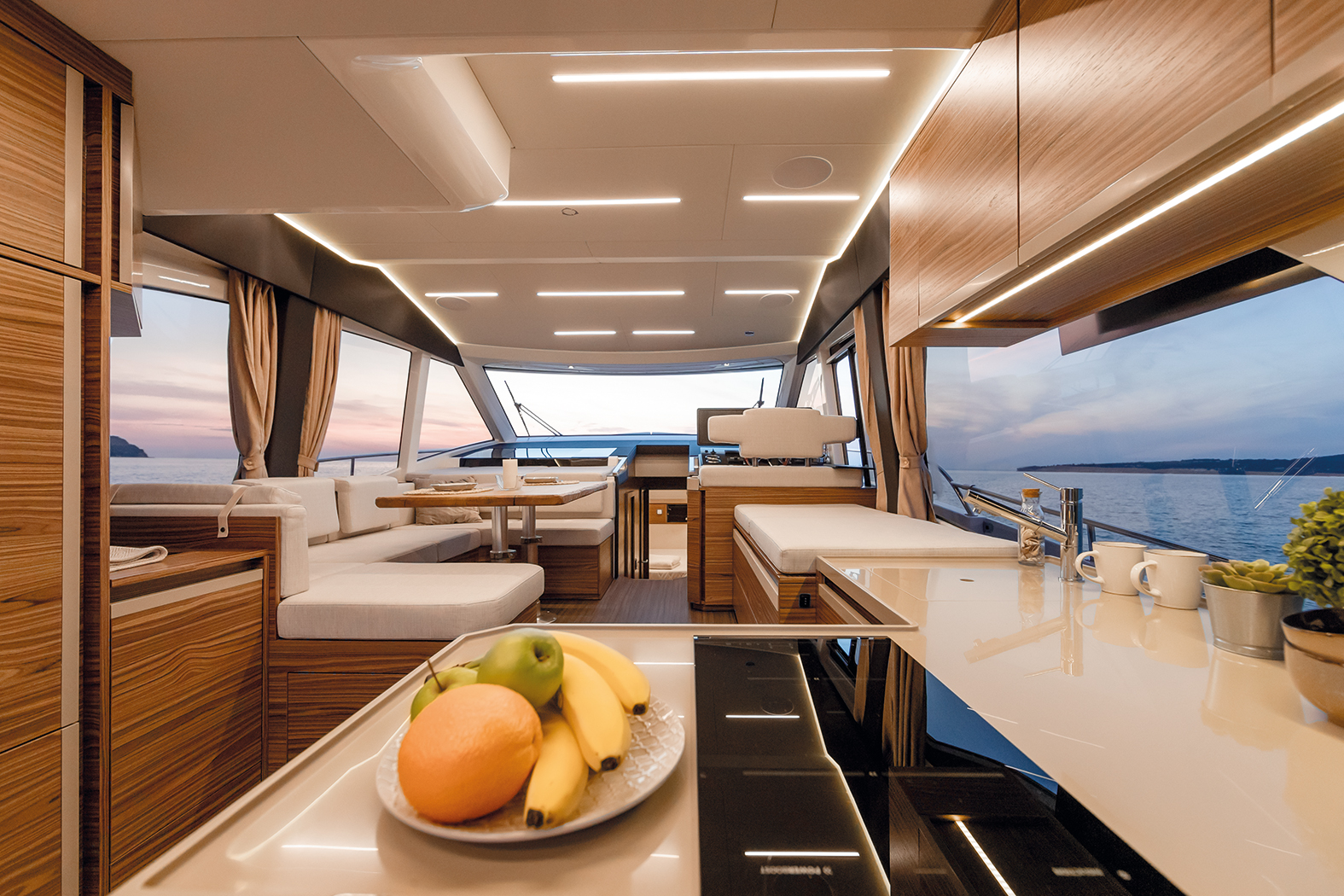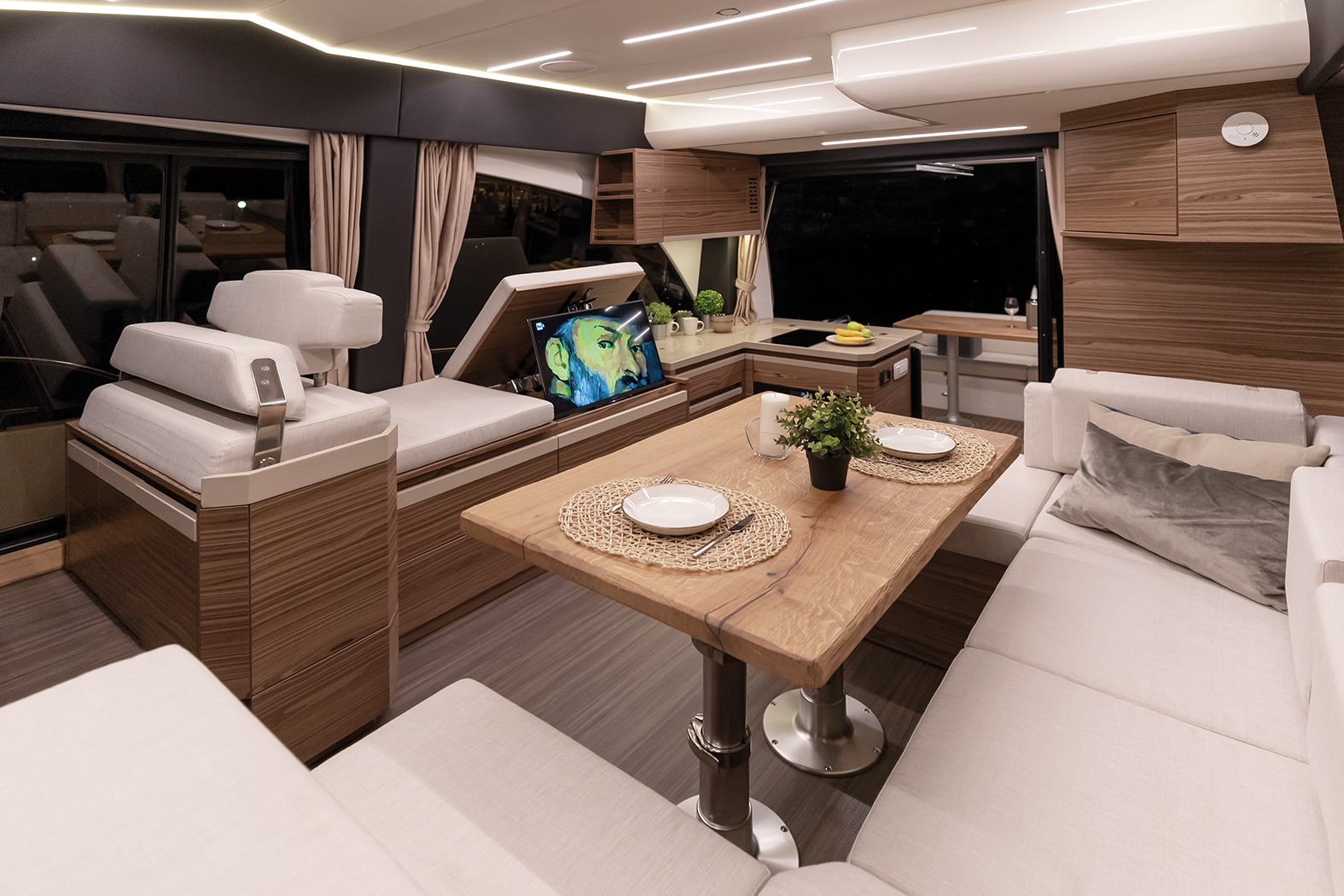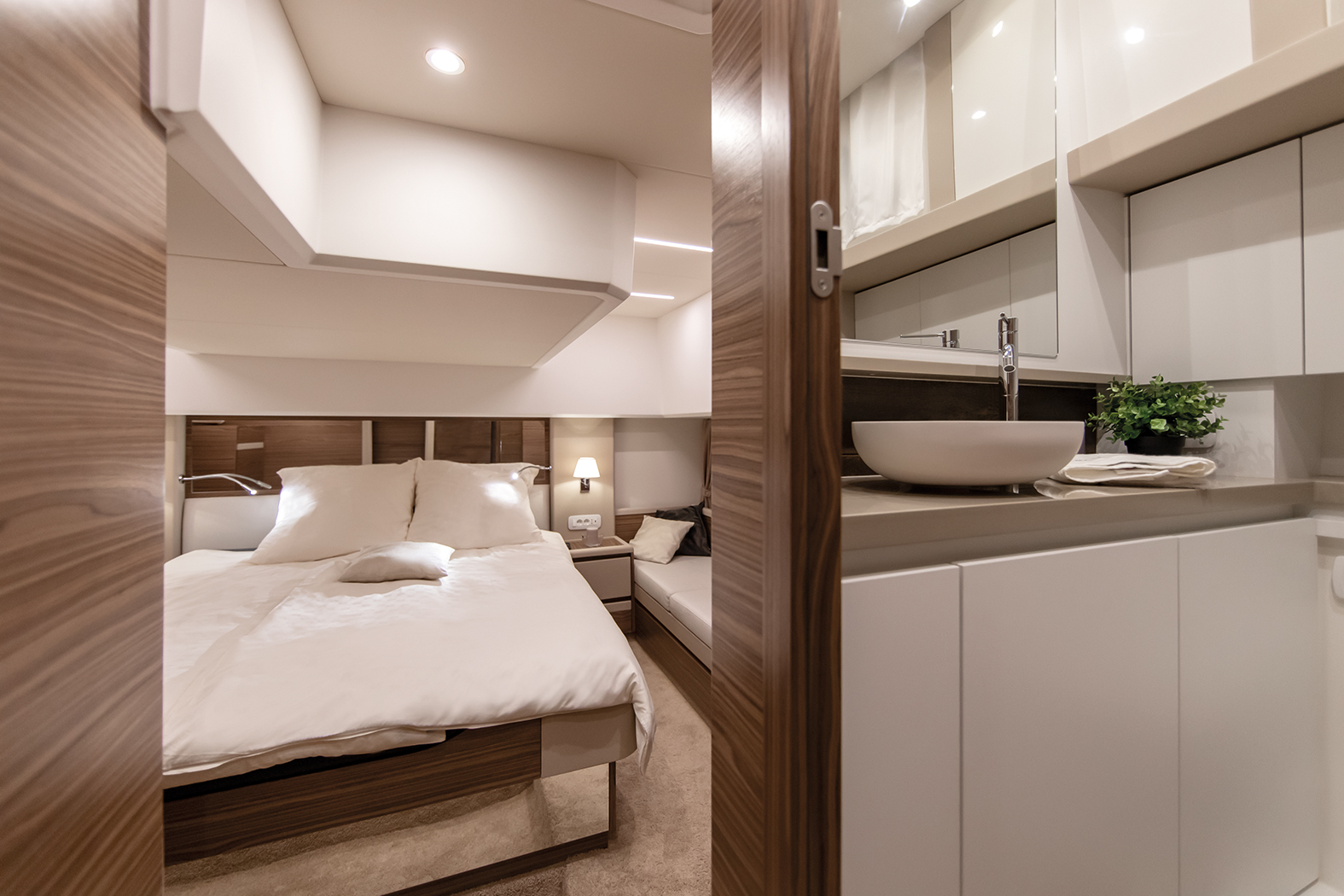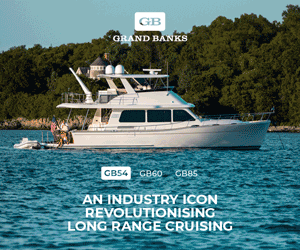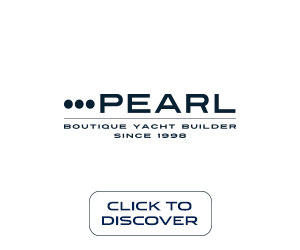Green with envy
Gone are the days when powerboats were differentiated between speedsters and trawlers. The Greenline 45 Fly sets a good example of how an efficient, fast hull can still offer a comfortable long cruising ride, says Phillip Ross.
16 March 2023
It has been close to 15 years since Greenline emerged from the drawing boards of J&J Designs, and the European builder has enjoyed considerable success since then – its first model, the Greenline 33, sold 550 hulls.
Greenline has also gone to great lengths to offer alternatives to conventional fossil-fuel boating, with solar panels and hybrid drives coupled to efficient hulls a key tenet for the brand. The Greenline 45 Fly and Coupé models are no different. Australian powerboat agency eyachts has sold this test Greenline 45 Fly to a Papua New Guinean owner.
The design will perfectly match the owner’s desire for extended cruising in a luxury style not necessarily seen in a standard 45-footer. As eyachts principal Peter Hrones notes, Greenline has built a reputation on its environmental credentials.
However, hybrid sales are in their infancy in Australia – indeed, the owner of this 45 Fly opted to upgrade to the powerful twin 370 hp Yanmar diesel engines.
That power, as I soon learn, makes for a dynamic yacht that delivers strong performance while still offering extended cruising if you’re prepared to throttle back.
Taking her for a spin in Sydney, a 360-degree turn at full throttle was wide but not excessive considering the style of design. She took the swell – and the chop when cutting across the wake of other craft – in her stride, with nary a drop of water on the foredeck.
At wide-open throttle, we hit 25.3 knots within 20 seconds while punching into a strong Middle Harbour breeze on flat water. It’s a great response, but speed is not what this boat is built for – and at that speed, you’ll empty your full fuel tanks in half a day. At about 14 knots, she sat up onto the plane.
Any manoeuvring, either at high or low speeds, showed minimal turbulence through the helm. Even at high speeds, heel was under 10 degrees and at no time did she display a lack of grip. Roll it back to cruising speed at 1,000 rpm and you will sit on 6 to 6.5 knots for a respectable 1,000 nautical miles.
While our test boat’s upgraded engines pushed a hull designed for shafts, there are several options with a tweaked hull to suit – the Volvo Penta IPS 500s or IPS 600s come on a non-tunnel hull. Other options include Yanmar 320 hp diesels; Greenline’s hybrid diesel-electric drive with Volvo Penta D3 200 hp diesel; or the fully electric twin 100-kilowatt Torqeedo inboard propulsion units with four added battery banks.
While this owner chose the full fossil-fuel option, Greenline still clings to its environmental credibility by placing two inbuilt 300-amp solar panels on the cabin top in front of the flybridge.
They trickle feed the batteries, allowing longer battery use without having to fire up the generator. With the solar-panel feed, the batteries can run the air conditioning while at anchor for most of the day while still coping with all the other domestic loads.
The optional flybridge hardtop option and the 45 Coupé version offer space for even more solar panels. Green credentials aside, this is still a well thought-out boat for any lifestyle lover.
You can sit on the large hydraulic swim platform and lower it into the water for a cool cocktail hour, or use it to lower the tender from the toy storage under the aft deck. It is here that the new owner intends to install an outdoor kitchen area with a sink, barbecue and bench space, which the full-width area provides. Up the steps is the full-width aft deck.
The doors to the interior either slide away completely or fold up to create an insideoutside area that allows, with the galley right there, easy access to all the amenities.
Bringing out the deck chairs or using the four-person lounge across the transom makes for an inviting social area.
Access to the engine room is easy, and this area is well laid out with daily maintenance checks right to hand. High bulwarks ensure safe passage forward. The foredeck invites relaxation with sunbed cushions across the cabin top, while two automatic pop-up lights make the space usable long into the night.
The 20-kilogram anchor sits snugly against its roller, with the chain leading down into a deep locker for storing fenders and mooring lines. Indeed, the beamy hull sections mean that everywhere on the boat there’s plenty of storage space.
Stairs to the flybridge are to port and put you right behind the helm station, with the starboard side up top fully taken with a big daybed area. Aft of the flybridge is a full-width U-shaped lounge and table. A little mini bar makes this the perfect spot to watch the world go by as you speed along. The bimini top is fabric and folds, targa-like, back against the rear arch.
When extended, LED lights provide a lovely soft tone in low light. Inside, the owner chose to upgrade the golden oak trim to grey oak, which is hardy and subdued. The well-finished leather trim cuts any idea of plainness, while the Kerrock benchtops add a slight tan tinge to the interior and come with fiddles for safety.
The expansive windscreen is a single piece with no mullions to obstruct the view, and the view from the inside helm is extensive. The port aft quarter vision is blocked by the flybridge stairs, which is why Greenline positioned the flybridge helm up top to port; that way, whether docking to port or starboard, your vision is covered. The inside helm also has its own door to the side deck – quite a novelty on a boat this size.
There is also a starboard opening door in the bulwark to allow the skipper to moor alongside singlehanded. Navigation equipment on our test boat comprised standard Simrad 12-inch touchscreen, multi-function displays at both helm stations as well as VHFs, controls for the autopilot and joysticks for the stern and bow thrusters.
The saloon area seats four comfortably, and our test boat had a storage area to starboard that also housed a large television; another option is to replace this with two helm chairs. The galley can be tailored to the owner’s needs but offers a full-size refrigerator/freezer, a conventional oven with microwave and convection, and an induction cooktop.
Our test yacht featured the three-cabin configuration that features a bunk berth cabin to starboard and a master cabin to port with the day shower/head forward of that.
The VIP cabin is nestled in the bow and benefits from the full bow sections above the waterline – indeed, this might well become the owner’s go-to cabin when not travelling with guests. There’s lots of light from opening hull ports, plus the cabin’s top-side windows have views through cut-outs in the side bulwarks.
There’s a staggering 2.4-metre headroom at the foot of the queen bed and also direct access to the portside head. The head is a bit of a squeeze, and it might make sense to remove the shower door so you could use the whole head as a wet-room shower.
The starboard midships twin-bunk cabin can be alternatively specified as walk-in wardrobes for the VIP and master suites – something that is well worth considering if you typically cruise as a couple.
The master cabin is larger but, being down aft, lacks natural light. Headroom is still excellent, but you do need care when transitioning between the foot and the side of the bed. The cabin benefits from a 4-metre beam for the king-size bed and walkaround space, while the headroom is 1.9 metres at the bed foot.
The master ensuite is larger than the day head and plenty comfortable enough; there’s also a shower seat.
With its solid hull and deck in sandwichfoam, vinylester-infused resin build, the Greenline 45, in whatever configuration you dream it, is designed for long-term cruising and a comfortable lifestyle. And, while the Australian market may not yet be ready for the full hybrid or electric options, the more conventional packages still offer plenty to tempt you.


